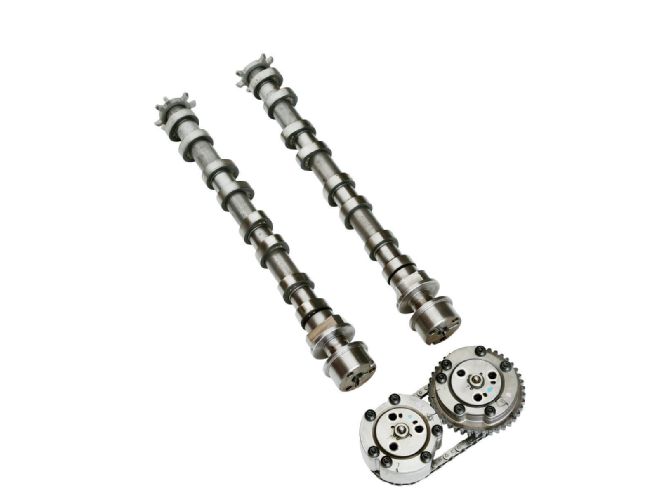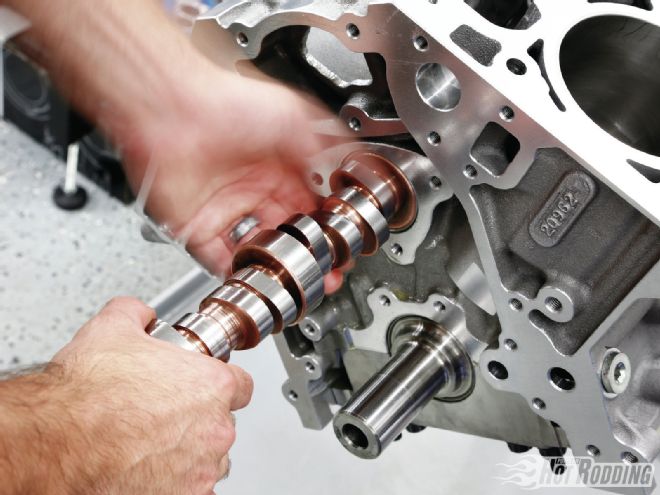
You’d think that 150 years would be long enough to solve a problem, but no such luck. Since the first four-stroke internal combustion engine rolled out the gate in the late 1800s, engineers have been beating their heads over the great compromise known as camshaft design. That’s because a motor running at low rpm is a completely different animal than the same motor at high rpm, as the dynamic effects of the intake and exhaust charge at both extremes require vastly different valve event timing. Until someone figures out how to reliably run two camshafts simultaneously in one engine, the duration and lift ground into a camshaft will always be a compromise between low-end torque and top end power, with variables like idle quality and driveability further complicating the situation.
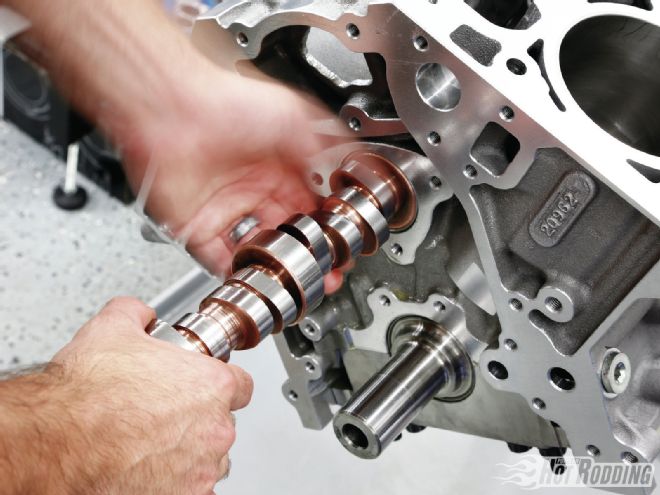 In the past, cam phasing could only be accomplished on an engine stand. Modern VVT systems can now electronically change cam timing on the fly while an engine is running at WOT.
In the past, cam phasing could only be accomplished on an engine stand. Modern VVT systems can now electronically change cam timing on the fly while an engine is running at WOT.
Fortunately, GM, Ford, and Chrysler have all devised ingenious methods of altering the valve timing in their production V-8 engines in recent years. Although changing the timing of the valve events doesn’t affect engine output as much as altering cam duration and lift, advancing or retarding cam phasing by a few degrees—called Variable Valve Timing (or VVT for short)—can still yield dramatic changes in the shape of the horsepower and torque curves. Thanks to the technical aptitude of companies like COMP Cams and Mast Motorsports, what was once a compromise is now a genuine performance advantage.
The Need for Variable Timing
On an engine dyno, advancing or retarding a cam for optimum performance is a critical component of every test session. Advancing the valve events boosts low-end torque at the expense of high-rpm horsepower, while retarding the cam has the opposite effect. Similarly, drag racers will often tweak the cam phasing of their motors with adjustable beltdrive timing sets to maximize off-the-line traction. In both scenarios, manipulating the intake valve closing point effectively shifts where in the rpm band an engine produces the bulk of its horsepower and torque. Since engines are nothing more than air pumps, and the valves regulate the flow of air into and out of an engine, getting the timing of the valve events just right is a necessity, not a luxury.
Valve timing simply refers to when the four valve events—intake valve opening, intake valve closing, exhaust valve opening, and exhaust valve closing—take place in relation to position of the crankshaft and pistons. The four valve events are a major consideration in cam design, and thus clearly disclosed on every cam card. While each of the four valve events affect engine output differently, intake closing is by far the most important, as it determines how much air an engine can ingest on the intake stroke. For maximum power, delaying the intake valve closing point allows drawing more air into the cylinders at high rpm. This is why most aftermarket performance cams have an intake valve closing point of 60-70 degrees after bottom dead center.
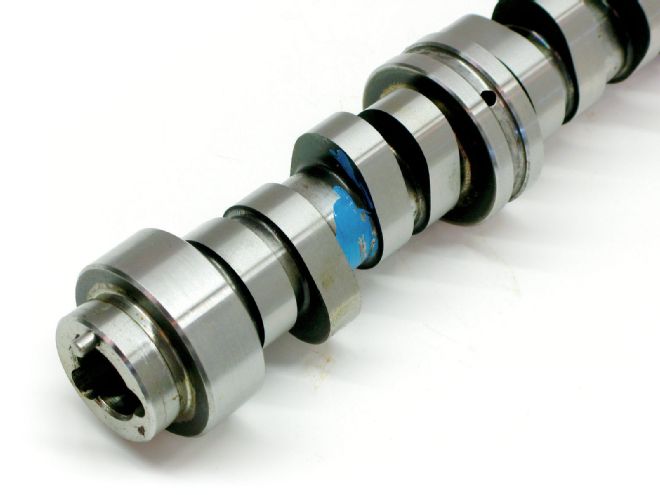 Unlike a standard cam, the cores used on GM’s VVT cams are hollow. A grooved No. 2 cam journal with a drilled passage directs oil to the front of the cam to feed the hydraulic phaser assembly. The Ford and Chrysler VVT systems incorporate a very similar design.
Unlike a standard cam, the cores used on GM’s VVT cams are hollow. A grooved No. 2 cam journal with a drilled passage directs oil to the front of the cam to feed the hydraulic phaser assembly. The Ford and Chrysler VVT systems incorporate a very similar design.
At low rpm, a delayed (or retarded) intake closing allows the pistons to push the air/fuel mixture past the intake valve and back into the intake manifold, compromising low-end torque. Conversely, although it may seem counterintuitive to leave the intake valve open while the piston is traversing back up the bore after bottom dead center, it substantially improves cylinder filling. “Even if the intake charge had zero mass, the cylinder would still be at a lower pressure than the intake plenum at BDC as the air flows in to fill the void. As the piston begins to return upward, the pressure will balance across the valve,” Billy Godbold of COMP Cams explains. “At this point, the forces are balanced across the valve, but the air molecules still have sufficient inertia for continued cylinder filling. As the intake charge continues to fill the cylinder, the port velocity will drop due to the increasing cylinder pressure and the closing of the intake valve. The point at which the port velocity hits zero—when the last oxygen molecule passes the intake valve and the first oxygen molecule heads back into the intake manifold—is theoretically the ideal intake closing point.”
Since arranging the valve events to boost high-rpm horsepower hurts low-rpm torque, and vice versa, the installed centerline of a camshaft is ultimately a compromise, however, the beauty of VVT systems is that they eliminate this compromise entirely by advancing the cam phasing at low rpm, and slowly retarding it as rpm increases. This allows maximizing low-end torque without compromising top end power, and maximizing top end power without compromising low-end torque. Furthermore, VVT also broadens the torque curve before the peak, and prevents horsepower from dropping off rapidly after the horsepower peak. “With variable valve timing, we typically see a 5-10 percent improvement in output at the ends of the torque and power curves,” Godbold says. “This means that torque output will improve dramatically 1,000-2,000 rpm below the torque peak, and the engine will continue making usable power up to 1,000 rpm above its power peak instead of falling off a table. Clearly, VVT flattens the torque curve substantially.”
How VVT Works
While there are notable differences in the VVT systems designed by GM, Ford, and Chrysler, all three are very similar in overall execution. In the GM Gen IV and Chrysler Gen III Hemi motors, oil is diverted from the cam bores into a hollow camshaft core. From there, the oil travels forward through the front of the cam and into the cam gear. In addition to synchronizing the camshaft with the crankshaft, the cam gear doubles as a phaser assembly that can alter the cam orientation roughly 50 degrees. The hydraulically actuated phasers channel oil to different cavities and passages within the phase bodies to advance or retard the cam. Providing precision computer control over the entire process is an electric solenoid mounted in the timing cover that applies pressure to an oil control valve bolted to the nose of the cam. The solenoid interfaces with the ECU, cam position sensor, and crank position sensor to adjust cam phasing within a fraction of a degree. The VVT system used in Ford’s 5.0L DOHC Coyote platform operates on a very similar principle, but since it has four camshafts it requires four sets of phasers and solenoids.
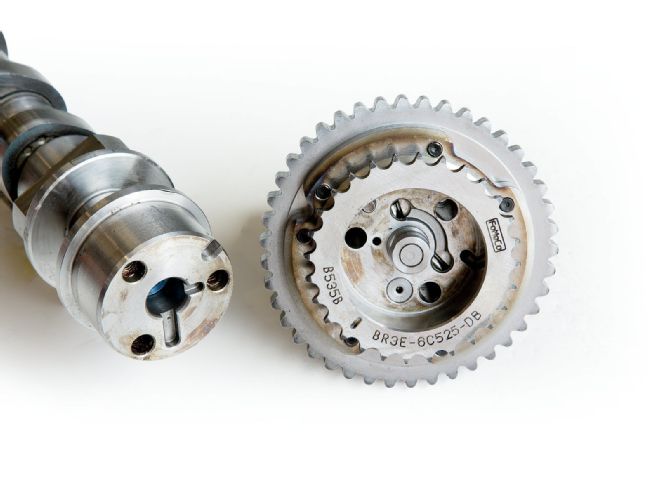 The back of the Coyote’s phaser assembly features an integrated oil control valve that fits into the cam face and directs oil into different parts of the phaser to manipulate cam positioning. In the GM system, a single cam bolt holds the phaser to the cam and doubles in function as the oil control valve.
The back of the Coyote’s phaser assembly features an integrated oil control valve that fits into the cam face and directs oil into different parts of the phaser to manipulate cam positioning. In the GM system, a single cam bolt holds the phaser to the cam and doubles in function as the oil control valve.
Aftermarket Hop-Up Tricks
Much like old-school hot rodders ditched EFI for carbs and tossed HEI distributors in the trash for their trusty points-style systems, the perceived complexity of modern VVT systems scares off many traditionalists. Given the enormous performance advantages of VVT, however, it seems ludicrous to disable it when upgrading to an aftermarket camshaft. “Having the ability to tune intake closing, then saying ‘no thanks,’ is like being able to reliably tune spark timing but choosing to lock it in one setting instead. The real difference is that the engine actually responds more favorably to tuning the intake closing at different rpm than it ever will to spark timing,” Godbold says.
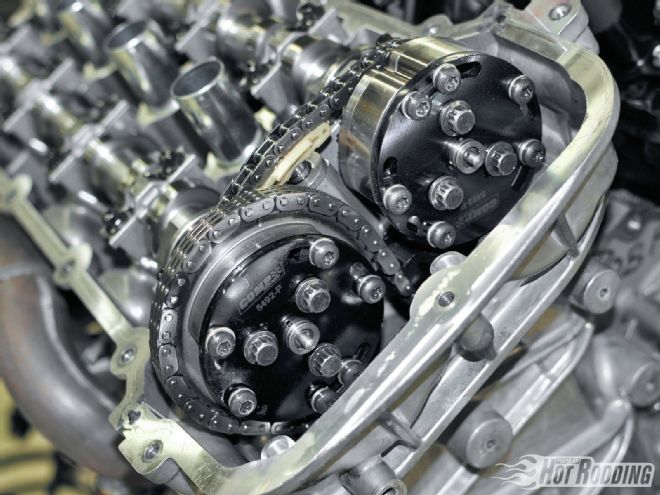 With two sets of camshafts for each cylinder head, the Ford 5.0L Coyote’s VVT system has four times the hardware of a cam-in-block setup. In the Coyote, the exhaust camshafts are driven by a chain off of the crank gear, and a shorter chain connects the intake cams to the exhaust cams. The payoff of this complexity is individual control over both the intake and exhaust lobe phasing, and the flexibility to alter the lobe separation angle.
With two sets of camshafts for each cylinder head, the Ford 5.0L Coyote’s VVT system has four times the hardware of a cam-in-block setup. In the Coyote, the exhaust camshafts are driven by a chain off of the crank gear, and a shorter chain connects the intake cams to the exhaust cams. The payoff of this complexity is individual control over both the intake and exhaust lobe phasing, and the flexibility to alter the lobe separation angle.
While VVT systems do indeed require special precautions before subjecting them to the standard bevy of hop-up tricks, the aftermarket has you covered. “Hydraulic pressure is the only thing preventing the pressure of the valvesprings from forcing the phaser into full mechanical retard, which would send the exhaust valves crashing into the pistons. To prevent this, we install restrictors into the phaser that limit cam movement to 20 to 30 degrees,” Horace Mast of Mast Motorsports says. Likewise, Mast has documented less precise control of the camshaft phasing at high rpm once valvespring pressure exceeds 380 pounds. As another safeguard, Mast uses pistons with extra-large valve reliefs in its VVT-equipped crate motors.
Taking precautionary measures to ensure reliability is one thing, but having the know-how to fully extrapolate all the performance potential of a factory VVT system is another issue entirely. As one of the first companies to offer performance VVT camshafts for the GM Gen IV small-block, Mast Motorsports has learned a few tricks over the years. “Compared to a non-VVT camshaft, our custom VVT cams have 5-10 degrees of retard ground into the installed centerline. This enables us to take full advantage of the VVT system,” Mast says. When GM first introduced VVT into its Gen IV motors, no one knew how to control the cam phasing with the factory computer. Mast’s M-90 stand-alone engine management system has proven to be a tremendous development tool. From the very beginning, it allowed Mast to precisely control the cam phasing in real time for maximum performance.
DOHC Flexibility
With cam-in-block OHV motors like the GM Gen IV and Chrysler Gen III Hemi, phasing the cam changes all four valve events at the same time. This isn’t ideal, since different scenarios call for moving the valve events in different directions. For instance, retarding the intake closing for improved top end power also delays the exhaust opening. The problem is that retarding the exhaust opening actually sacrifices high-rpm power since spent fumes can’t exit the cylinder until later in the exhaust stroke. On the other hand, DOHC cam motors like the Ford 5.0L Coyote can phase both intake and exhaust cams independently from each other for even greater flexibility. In fact, the Coyote’s independent phasing allows altering the effective lobe separation angle of the camshafts. “The big benefit of DOHC variable valve timing systems is that they can optimize the intake closing and exhaust opening points for any given rpm and throttle position. While these two points are the most important of the four events, the intake closing tends to trump the exhaust opening effect in typical systems, which explains why VVT in OHV motors still works so well,” Godbold says. “Optimizing exhaust opening allows controlling the overlap for better cross talk between intake and exhaust in the rpm windows where the exhaust wave is properly synchronized to dip into the chamber pressure at intake opening. These independent systems provide even greater improvements at the ends of the torque curve. Additionally, they also provide the opportunity to further optimize overlap in the midrange to improve peak performance. On the dyno, the horsepower and torque improvements offered by a DOHC VVT system are 25 to 50 percent greater than with a cam-in-block VVT arrangement.”
The key to electronically controlling a hydraulically actuated VVT system with the ECU is an electric solenoid (left) mounted on the back side of the timing cover. It presses down on the oil control valve to change cam phasing almost instantaneously. The GM cover (shown) is modular in design and bolts right up to non-VVT Gen IV motors.
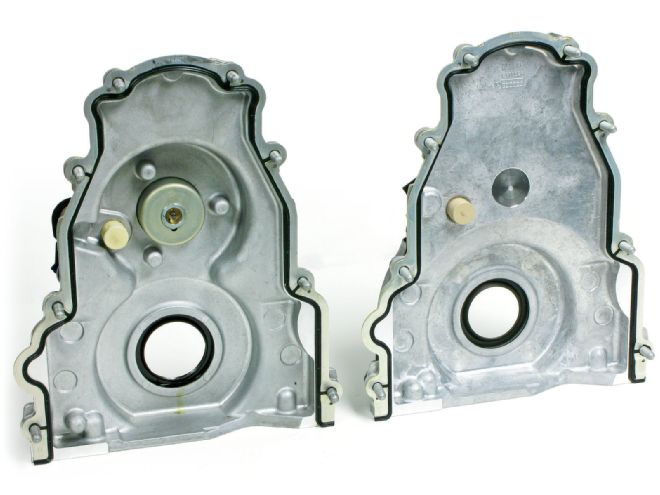
Although the GM phaser allows for up to 52 degrees of movement, both COMP Cams and Mast Motorsports include steel restrictors with their VVT cam kits that limit movement to 20 to 30 degrees. This not only prevents piston-to-valve interference with long-duration cams, but it also reduces the oil capacity inside the phaser. This speeds up how quickly the phaser can react to tuning changes.
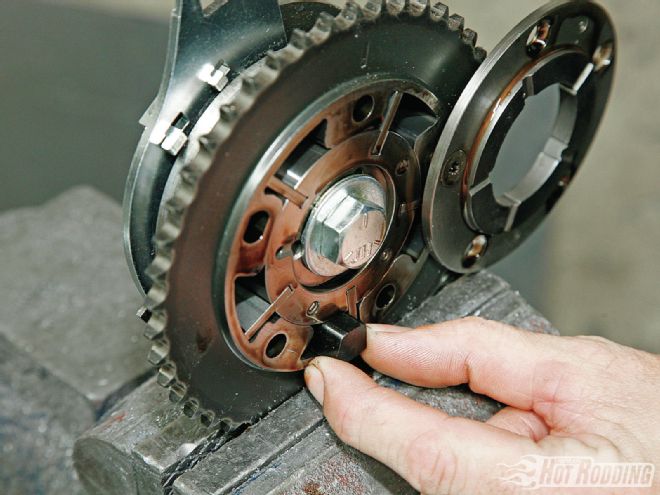
When tuned for maximum torque, Mast Motorsports’ 416ci L99 prefers 5 degrees of advance, while it produces maximum horsepower with 4 degrees of retard. To fully take advantage of the VVT system, however, Mast advances the cam an additional 2-3 degrees at idle and retards the cam an extra 4-5 degrees at 7,000 rpm. This not only bulks up low-end torque below the engine’s torque peak, but it also dramatically reduces the rate at which horsepower drops off after the engine’s 6,400-rpm power peak. Compared to when the cam is advanced for max torque, retarding the cam for max power produces 18 extra peak horsepower at 6,400 rpm. By continually delaying the intake closing after peak power, at 6,900 rpm the difference is a staggering 40 hp.
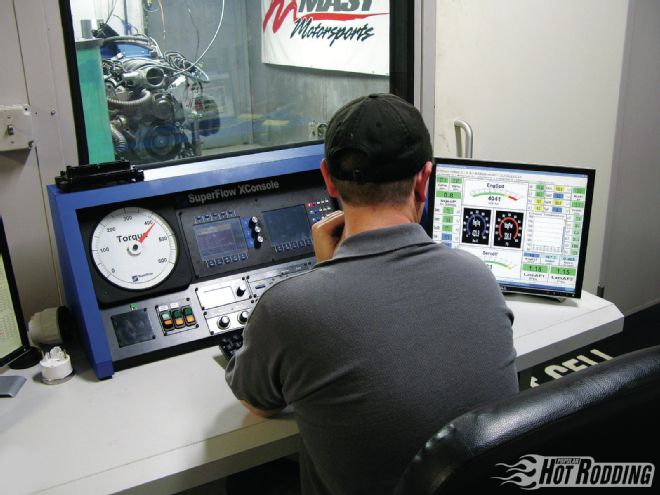
When VVT first debuted in the GM's LS small-blocks in 2007, tuners had yet to figure out how to unlock the factory ECU's VVT tables. Mast Motorsports' solution was developing its own stand-alone computer. The M-90 engine management system is designed specifically for LS motors, and allows tuning cam phasing based on rpm and intake manifold pressure. It will set you back $900. It's perfect for Pro Touring applications where a stock computer with optimal VVT tables isn't readily available.
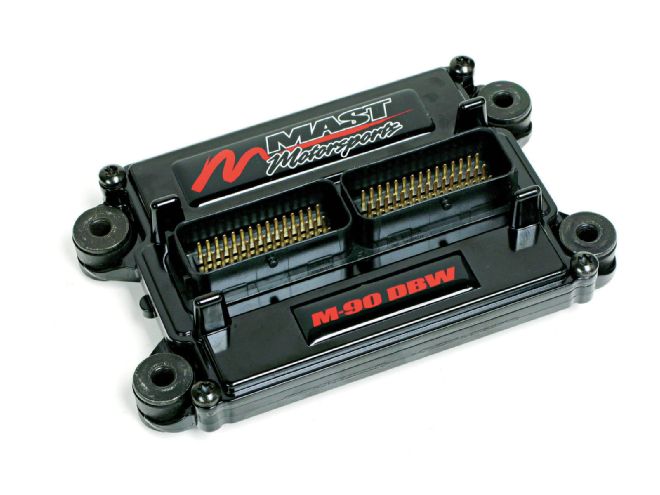
As one of the few companies that offer VVT-equipped crate motors, Mast Motorsports has conducted extensive dyno testing of GM’s VVT system on its 416ci L99 motors, which are rated at 595 hp. Retarding the cam for max top end grunt typically yields roughly 610 hp and 555 lb-ft of torque. Advancing the cam for max low-end performance nets 592 hp and 565 lb-ft of torque. It’s the classic case of compromise, but engaging the VVT results in a pull that retains both the peak horsepower (610) and peak torque of 565 lb-ft from the two prior pulls.
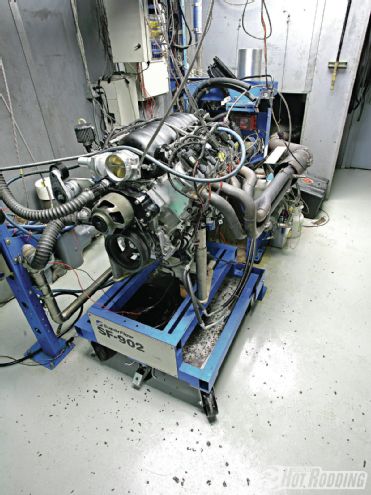
Fully recognizing the virtues of VVT in performance applications, COMP Cams has developed VVT-specific camshafts for GM Gen IV, Ford 5.0L Coyote, and Chrysler Gen III Hemi engines. Compared to non-VVT cams, they feature a more asymmetrical pattern to increase piston-to-valve clearance and take advantage of the inherent driveability advantages of a VVT system.
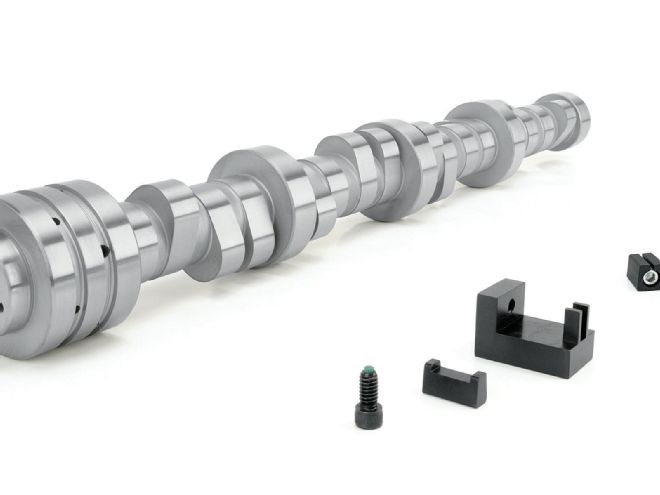
Granted that the Ford 5.0L Coyote’s VVT system offers the most flexibility amongst competing designs, adapting it to older mod motors isn’t practical since it requires swapping the cylinder heads and intake manifold. Likewise, Chrysler enlarged the cam bores and revised the oil passages in its VVT blocks, making it nearly impossible to retrofit VVT onto an earlier Gen III Hemi. The good news is that GM’s VVT system can easily be fitted to any non-VVT Gen III or IV LS small-block. All that’s required is bolting up a VVT-specific timing cover, camshaft, cam phaser, oil control valve, computer, and 58-tooth reluctor wheel.
